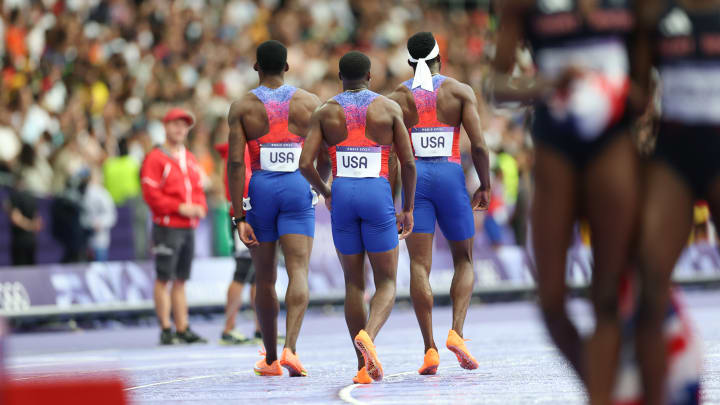Here’s What Went Wrong for the U.S. Men’s Relay Team Even Before the Disqualification

PARIS — The four women on the U.S. 4X100 relay team won gold, draped American flags around themselves, celebrated with fans, and slowly made their way around to the second turn of the purple track, where they huddled against a wall and watched a debacle.
Melissa Jefferson, Twanisha Terry, Gabby Thomas, Sha’Carri Richardson did not run a perfect race. The exchanges, especially from Thomas to Richardson, could been cleaner. But they showed the poise, teamwork and breathtaking speed that got them here—especially Richardson, who was a hair behind Great Britain and Germany when she got the baton and ran so fast that the scoreboard operator apparently couldn’t believe it. The board initially flashed that Great Britain had won gold, even though Richardson clearly finished first.
Richardson called it “a phenomenal finish for all of us.” She talked about “trusting Gabby and knowing she is going to put that thing in my hand no matter what.” Terry said, “we just trust one another. We have that pep talk before we walk in and we make sure everybody is comfortable … just keep doing what you need to do, don't try to search for [the baton] and I'm gonna get it to you.”
The men …. well, the men couldn’t say any of that, because Kenny Bednarek left too early and had to stop to get the baton from Christian Coleman. They didn’t complete the pass within the exchange zone and the United States added to its extraordinary history of relay disqualifications.
The women deserve all the plaudits they receive.
But the men were supposed to be past this kind of failure.
So what happened?
Well, the simplest answer was on Bednarek’s face afterward. His three teammates were disappointed. Bednarek was crushed. He did not answer any questions in two trips through the mixed zone—once after the race, and again after the medal ceremony for the men’s 200. But he knew he left too early, and that caused the DQ. Everybody knew it.
“I think it really just didn’t happen,” was all Coleman could muster. “I’m not sure if you want me to, like, point fingers or something like that.”
Fred Kerley, who ran the anchor, snapped at reporters repeatedly: “You all saw the same thing we saw … stupid question … y'all say the same s— over and over … dumb question.”
I have been at the Olympics for two weeks. I have heard a lot of stupid questions. I have surely asked a couple myself. There were no stupid questions for the American men Friday night—just questions they didn’t want to answer. Good on them for protecting Bednarek. But when a team runs faster in the prelim than any team ran in the final and gets disqualified, fans and reporters want to know what happened.
There is a longer and more nuanced answer than “Bednarek left too early.” It involves schedules, coaching decisions and nerves.
The U.S. women used the same four sprinters, in the same order, in Round 1 and the final: Jefferson, Terry, Thomas, Richardson. They could do this because they were all available: the women’s 100 final was four days before the 4X100 heats and the women’s 200 final was three days before.
The men’s 100 final was on Sunday. But the men’s 200 semi was Wednesday night, the final was Thursday night, and Round 1 of the 4X100 was in between, on Thursday morning. That meant that anybody who made the 200 final was probably not going to run in Round 1 of the relay.
You might say the schedule was the same for everybody. But actually, it wasn’t. Incredibly, of the eight countries competing in the 4X100 final, the U.S. was the only one with sprinters in the 200 final.
Canada, the gold medalist, ran the same four sprinters in the same order in both rounds of the relay. South Africa, the silver medalist, did the same. Great Britain, the bronze medalist, did make one change, but that appears to have been strategic: Richard Kilty, who ran the slowest third leg of anybody in Round 1, was benched for Zharnel Hughes.
As part of the revamped relay program, the Americans practice more together. But there are psychological benefits to running the same race in the same order on the same track the day before the final.
The U.S. coaches have emphasized continuity, uniformity and prioritizing clean passes ahead of raw speed. But the makeup of this particular men’s track team did not align with those emphases.
Of the three Americans who ran the 100 here, two—Bednarek and Noah Lyles—also ran the 200. The U.S. has not had two men run both the 100 and 200 since the 2004 Olympics. The coaches could have benched both Lyles and Bednarek in the name of continuity, but they are the two best sprinters on the team. I don’t know if there is a coach in the world who would do that.
Then Lyles got COVID-19. He was the reigning world champion in the 100 and 200, and he should have been the best weapon any team had in the 4X100, but his availability for the final was now in doubt.
In Round 1, the U.S. ran Coleman, Kerley, Kyree King and Courtney Lindsey. Teams do not announce plans ahead of time, but we can probably figure out what it was: Keep Coleman and Kerley on the first two legs for the final, and then put Bednarek third and have Lyles run the anchor. It was the best way to ensure continuity and also get the best sprinters in the world onto the track.
Presumably because he was still recovering, Lyles did not run the final. Marsh kept King in the relay—and kept him third, the same leg he ran in Round 1. Coleman still led off. But Marsh moved Kerley to the anchor leg and had Bednarek run second.
I don’t have all the data that led to that decision. But the anchor leg involves the least amount of curve of any of the four legs. Kerley is better at the 100 (no curve) than the 200 (curve). Bednarek is better at the 200. So there was clear logic to having Bednarek run the second leg and giving the anchor, the straighter leg, to Kerley.
It really does all make sense. But they don’t give medals for sense. In retrospect, the first indication that this plan might blow up came Thursday night, after the men’s 200.
Bednarek, who had finished second, said he thought he could have run a better race. A lot of silver medalists say that, but Bednarek’s reason seems telling: He said multiple times that he was unable to “relax” during the race.
The sprinter who missed Round 1 of the relay and said he couldn’t “relax” during a race Thursday night is the one who took off too early in the 4X100 final.
This is all much easier to see now, when we know what happened. But look at what the coaches’ options were at the time.
They could have looked at the schedule and benched their two best sprinters. Again: Who does that?
They could have kept Bednarek on the third leg, presuming that was the plan all along. But that would mean making King switch to second—and since King was the one who ran the relay the day before and was running in the first Olympic event of his life, that would have been riskier.
They could have had Bednarek run the anchor with Lyles out. I think of all the possible criticisms, this is the strongest. The U.S. would have kept the same 1-2-3 from Round 1: Coleman, Kerley, King. Bednarek, who missed Round 1, only would have had to be part of one exchange. The U.S. would have lost the benefit of having Kerley on the straighter leg and Bednarek on the curve, but all that would really cost them is time. The Americans had time to spare.
Of course, Bednarek still would have had to do the thing he failed to do Friday: leave on time and take the baton. He still would have been getting it from somebody he didn’t expect until Lyles got sick. So I don’t know how much difference this would have made.
With the U.S.’s history in this event, people will rip the program. It’s part of the deal. Kerley’s preemptive combativeness certainly will not soften the coverage. But a variety of circumstances made this race a little dicier than it should have been—and then Bednarek got antsy and botched the easiest part of a relay exchange: Leaving on time. He clearly felt awful about it. This was a human failure. It happens sometimes at the Olympics, and it’s wrenching every time.
